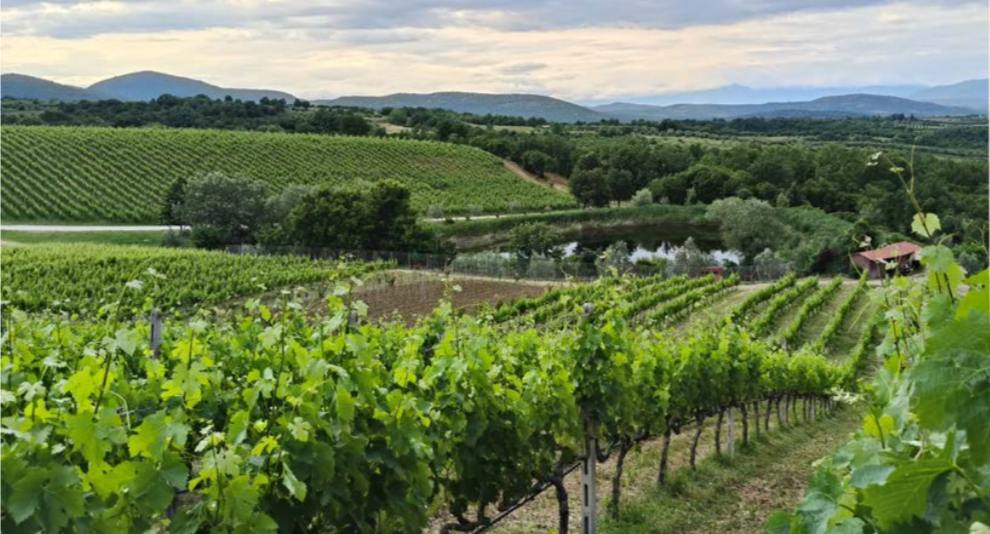« Sorry… No Beaches ! »
Welcome to Naoussa, the homeland of Xinomavro

“Sorry… No Beaches!” That’s the blunt yet ironic slogan used by the local Tourism board to promote Naoussa – a mix of reality and playful semantics. In truth, the phrase fits the city well, known historically as “Heroic Naoussa” for the tragic mass suicide of women and children during the Greek War of Independence, in 1822. Rather than return under Ottoman rule, they chose to drown into the Arapitsa River.
The same phrase could just as easily apply to Xinomavro, the grape for which Naoussa is the undisputed capital. A tough variety. Often thick-skinned, high in tannins. “Masculine,” some might say. It has found its home in the Imathia region, with Naoussa as its heart. This is Central Macedonia, 100 kilometers west of Thessaloniki, a key port connecting Western and Eastern Europe.
From Naoussa’s bustling main square, at an altitude of 330 meters, you can glimpse the horizon through the Municipal Park trees. The landscape blends into itself. The hill drops steeply, creating a sort of natural balcony. What looks like sea, from above, is actually the plain where the Arapitsa River runs slowly. The local microclimate owes much to Mount Vermio – snow-covered in winter – which moderates temperatures. Days are hot, but at night, a sweater is a must due to the sharp temperature drop.
These are ideal conditions for Xinomavro, a grape typically marked by distinct notes: dark fruit (blackberry more than cherry or strawberry), hints of beetroot, tomato pulp and leaves, layered over earthy, fresh-menthol aromas. Winemaking choices shape its profile – light and crisp or structured and age -worthy, often beyond ten years. This question is at the center of ongoing debate among the Association of Winemakers and Producers of Naoussa.
The effort to modernize the style hasn’t gone unnoticed. Greek Master of Wine Konstantinos Lazarakis, speaking in Naoussa on May 30 during the awards ceremony of the Balkans International Wine Competition, put it this way: “Xinomavro is not an easy variety to manage. Twenty years ago, a difficult grape had no commercial chance. Today, things have changed. We’re drawn to more complex, visceral grapes. In the ’80s and ’90s, everyone drank Cabernet and Chardonnay because they were easy, obvious, rich wines that jumped out of the glass. Now that kind of wine, to use a Greek word, is becoming an anathema. Wine lovers at large may still enjoy those classic grapes. But many winemakers, wine journalists, and sommeliers are seeking something harder to interpret. We see it in art, we see it in cinema. As genres evolve, the focus shifts from the obvious to the obscure. That’s the essence of Xinomavro.”
Lazarakis adds: “That said, Xinomavro can produce excellent rosés and sparkling wines, both white and rosé. And in red, it covers a full spectrum. From lively, fresh styles to Barolo-like wines that need decades to fully open up.”
Barolo, in fact, has long moved past its reputation for being overly tannic and austere, as seen in recent vintages “Anteprima”. In Italy, if Xinomavro resembles any wine, it’s generally not Barolo but Taurasi – the noble Aglianico from Avellino, in Campania. Like Naoussa, Taurasi is also reassessing its limitations and virtues, aiming for a more contemporary identity.
What surprises most about the remarkable Xinomavro-based reds from the heart of Macedonia is their exceptional value for money. “Welcome to Greece,” Lazarakis says. “Aside from Santorini, for various reasons, we’ve long held a very conservative, old-fashioned view on pricing. Today, in the wine world, if a bottle isn’t expensive, people assume it’s not good. But trust me: many Greek wines, if you changed the label and wrote ‘Tuscany,’ people would pay ten times more.”
It’s like a sunbed at a posh beach resort – often overpriced, and not necessarily cleaner than a public beach. But in Naoussa, again: there are “no beaches”. Just Xinomavro. And plenty to discover.
